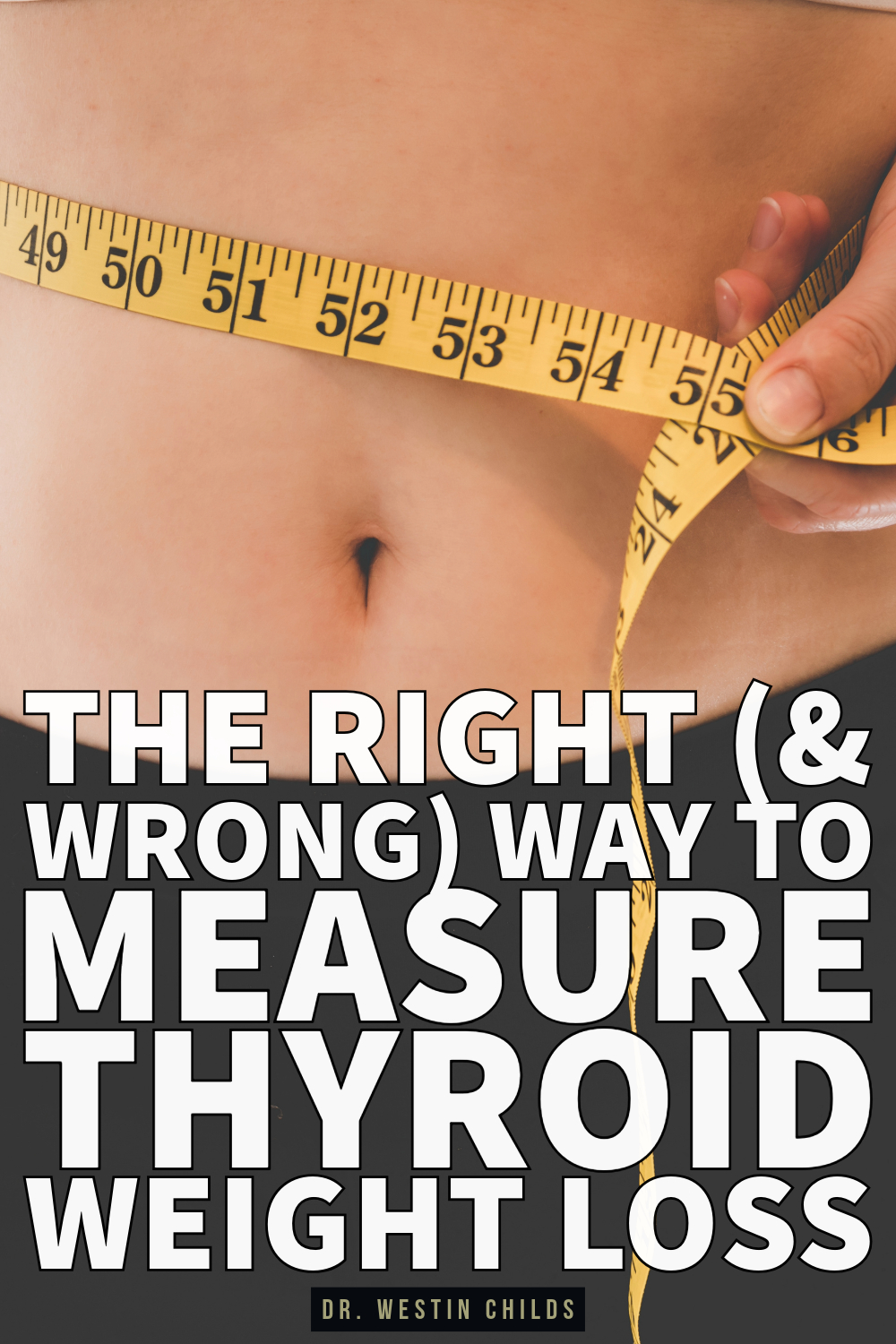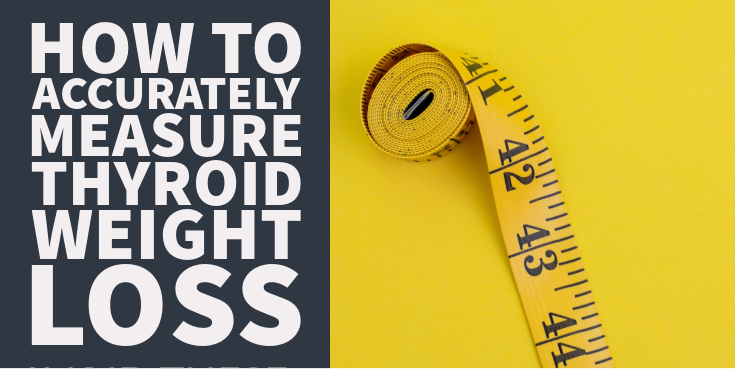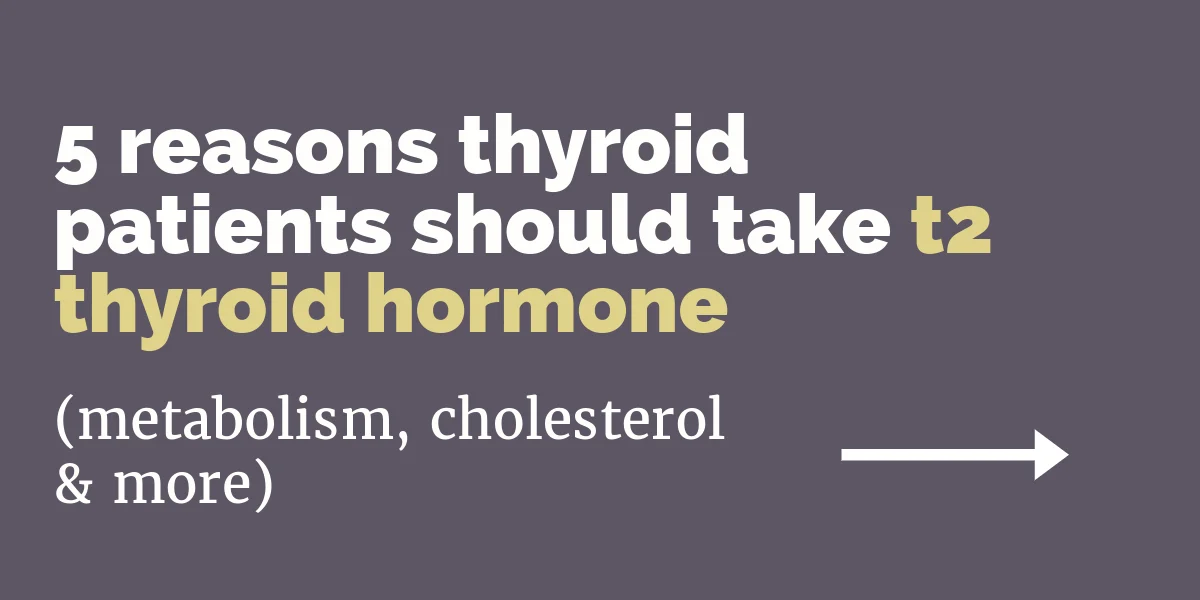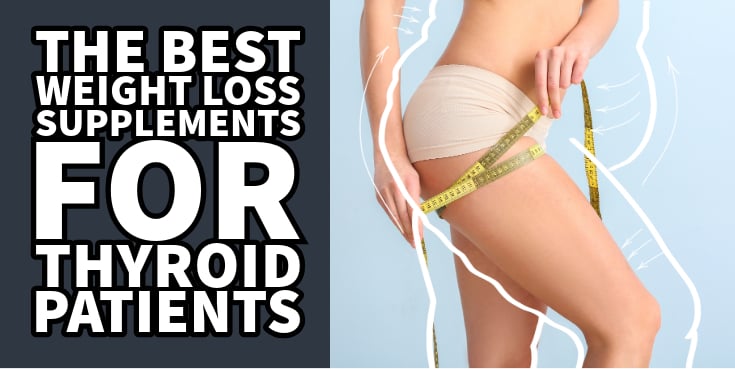Using a scale is one of the worst ways to measure weight loss if you have a thyroid problem for 3 main reasons:
Reason #1. Thyroid patients frequently suffer from rapid changes to their weight due to shifts in fluid.
These shifts do not represent changes in fat mass, but they can confused as such when using a standard scale.
Reason #2. Your weight on a scale does not necessarily represent how much fat is on your body.
It may be frustrating, but thyroid patients often do two things simultaneously when they start programs that help them lose weight the right way:
They build muscle and they lose fat at the same time and often at the same rate.
This means that, at least initially, the scale often stays the same even though whatever they are doing is working.
I can’t tell you how many thyroid patients I’ve seen stop doing what’s working because they don’t understand this concept.
At some point, your fat loss will overtake your muscle gain and the scale will start to decline, but that can take 6 weeks or more.
Reason #3. The scale doesn’t tell you if you are gaining or losing muscle.
And most people who lose weight lose a combination of both muscle mass and fat mass (1) which only ends up hurting thyroid function in the long run.
Your goal should always be to preserve as much muscle mass as possible when you lose weight (2).
Research has shown that skeletal muscle is a thyroid-responsive tissue which means the more you have (3), the more active your thyroid will be.
Given these three reasons, why then, do so many thyroid patients continue to weigh themselves daily using one of the most inaccurate measures of fat loss?
Probably because they don’t realize just how inaccurate it is and because pretty much everyone has a scale.
But I have some news for you, it’s actually very easy to measure your body composition and, therefore, your fat loss with just a few simple tools.
If you have a thyroid problem and you’re trying to lose weight, here are 4 ways (plus some bonuses) to accurately measure your fat loss:
DOWNLOAD FREE RESOURCES
Foods to Avoid if you Have Thyroid Problems:
I’ve found that these 10 foods cause the most problems for thyroid patients. Learn which foods you should avoid if you have thyroid disease of any type.
The Complete List of Thyroid Lab tests:
The list includes optimal ranges, normal ranges, and the complete list of tests you need to diagnose and manage thyroid disease correctly!
#1. Use body measurements
Instead of obsessing over your body weight as measured on the scale, focus more on your body measurements.
The size of your body is a more accurate way to assess fat loss for one reason:
Muscle mass is far more dense than fat.
Imagine if you gain 5 pounds of muscle and lose 5 pounds of fat at the same time, which is very common for thyroid patients who are losing weight the right way.
You might look at the scale and throw your hands up in frustration because whatever you are doing “isn’t working” when the exact opposite is true.
While this change in fat mass and gain in muscle mass are hidden in the scale, they are very obvious when you measure your body.
Because muscle is more dense than fat, the 5 pounds of muscle that you gained takes up less space than the 5 pounds of fat that you lost.
As a result, your body shrinks.
That shrinkage can occur anywhere, by the way, primarily depending on your genetics, which is why measuring multiple places on your body is important.
While hypothetical, this example illustrates an important point:
Your weight on the scale is rarely an accurate representation of your body composition.
And when thyroid patients are trying to lose weight what they are really trying to do is reduce their fat mass.
It just so happens that you’re almost always going to gain muscle mass along the way.
We will get into how to use the scale correctly in just a minute but, for now, let’s talk about measuring your body.
Before starting your weight loss journey (and preferably each week) measure your body in the following areas:
- Chest (at the level of your bra line)
- Waist (2 inches above the belly button)
- Stomach (at the level of your belly button)
- Hips (at the widest portion of your hips)
- Thigh (at the fullest portion of your thighs)
- Upper arms (at the fullest portion of your arms)
- Calves (at the largest portion of your leg)
You don’t have to take all of these measurements, but make sure to hit the major ones including chest, waist, stomach, and hips.
The others may be more important depending on where you hold your body fat which, again, is primarily driven by a combination of your genetics and your hormones.
When you are on the right track, you will see these measurements decrease (with some exceptions including those who are actively building muscle mass).
The best part? All you need is a simple measuring tape.
#2. Take weekly progress pictures and use the mirror.
While not necessarily as accurate as quantifiable metrics, you have to remember the primary reason that thyroid patients want to lose weight (and pretty much most people in general) is to look better.
And what better way to assess this subjective measurement than using your own eyeballs?
On top of the body measurements mentioned above, I would strongly recommend that you take weekly progress pictures during your weight loss journey.
Not only will these serve as a tool for accountability, they can also be downright inspiring.
While you may not see immediate changes on the scale when you first start your weight loss journey, it’s great to physically see changes in the mirror or in pictures.

Weight loss is hard enough as it is, so anything that inspires you or motivates you to continue is a good thing.
These pictures don’t have to be complicated, all you need is to take pictures of your front, back, and side each week.
Just make sure you use the same angles, wear the same clothes, and have consistent lighting when taking these pictures.
From here you can use free software on your phone to put your pictures side by side and bask in the success of your results.
#3. Body fat calipers to test skinfold thickness
Another simple way to measure body fat is with the use of body fat calipers.
These calipers measure and quantify the thickness of your skin which provides insight into your fat mass.
In the most simple sense, the thicker your skin, the more fat you have.
The thinner your skin, the less fat you have.
While it sounds simple in theory, body caliper testing is not as accurate as you might think (4).
If you accidentally grab more skin one week compared to the last then your results will almost certainly be off.
In addition, because of genetics and hormones, the places you lose fat while first will vary from the next person.
So you could very well be someone who loses fat in their breast tissue before losing fat on your stomach or arms.
And the opposite could be true for the next person.
Finally, thyroid patients have to contend with water retention which can complicate the accuracy of caliper testing.
For these reasons, calipers certainly aren’t better than the other methods we’ve discussed so far but they are incredibly cheap and do provide useful information.
If you plan to take caliper readings then here’s where you’ll want to do it:
- Triceps (back of the arms)
- Thigh (center of your leg)
- Suprailiac area (muffin top area)
If you don’t have one already, you can get a caliper on Amazon for a reasonable price.
#4. Use the scale, but calculate your average weight over 7 to 10 days
I can tell that you’re not quite ready to throw away your scale because, after all, old habits tend to die hard.
And if you don’t want to, I have some good news for you:
Your measurements on the scale can still provide some information that may be valuable to you, provided you are using the scale correctly.
Here’s the wrong way to use your scale:
Measure your body weight every morning (or every night) and get emotional based on what number pops up.
When the number on the scale trends down, pat yourself on the back, convince yourself you’re doing the right thing, and maybe even allow an indulgence or two because you probably deserve it.
When the number trends up, get upset and assume that whatever you are doing must not be working.
Make snap decisions about your diet, deviate from your tried and true weight loss routine, and maybe even avoid a few meals to try and get back on track.
I’m obviously exaggerating here to make a point but this may not be far off from how you (and many others I might add) use the scale.
Instead, here’s how to use it correctly:
First thing in the morning (AFTER going to the bathroom) get on the scale and write down your result.
Do this every day for 7 to 10 days.
At the end, combine all of your numbers and take the average.
This will give you your average weight over the last week.
From here, do it again for the next week and continue to do this over the course of 6 weeks.
Now that you have a weekly average, look at the trend.
Your weekly average will be a far more accurate representation of your weight than your daily measurements because body weight can fluctuate dramatically from day to day, especially for women.
Things like the menstrual cycle, food volume, stool frequency, and fluid retention can all impact your daily measurements but these variables can be smoothed out by taking a weekly average.
Instead of getting emotional, stay level-headed and trust in the process.
Use your results from your weekly averages in concert with your weekly pictures and weekly body measurements.
Takeaways
- Avoid using the scale as a sole metric of your weight loss success
- Fat mass and muscle mass (body composition) are more important than your body weight
- When you are losing weight correctly, your muscle mass should increase and your fat mass should decrease
- Diets that will ultimately harm your thyroid often result in equal parts fat loss and muscle loss (these are incredibly harmful to your metabolism and should be avoided)
- Simple ways to assess your body composition include body measurements, caliper testing, weekly progress pictures, and your weekly average measurement on the scale
- When you are losing weight the right way, the scale may not go down for 6-8 weeks
As far as expectations go, just remember that as a thyroid patient, it will be more difficult for you to lose weight compared to the average person.
On top of this, the same rules and principles that apply to non-thyroid patients will not often apply to you.
Instead of getting frustrated, embrace the differences and modify your expectations.
Disappointment is the difference between your expectations and reality, so as long as your expectations are set correctly, you won’t be disappointed.
If you need help losing weight, here are some resources that can help:
- The best thyroid medication for weight loss
- My weight loss supplements formulated for thyroid patients (and weight loss guide)
- The perfect thyroid diet (how to use diet for weight loss)
- The best prescription medications for weight loss
- How levothyroxine can contribute to weight gain
- Hashimoto’s weight loss success story
Scientific References
#1. ncbi.nlm.nih.gov/pmc/articles/PMC5421125/
#2. https://www.ncbi.nlm.nih.gov/pmc/articles/PMC6315740/
#3. https://www.ncbi.nlm.nih.gov/pmc/articles/PMC4037849/
#4. pubmed.ncbi.nlm.nih.gov/718832/









